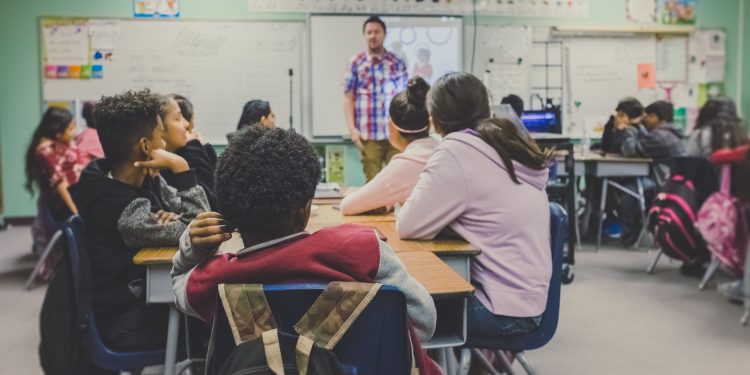Paperless classroom

Introducing educational technology in the classroom is not anymore an option. It begins to be a necessary change. Social media, the Internet, and a variety of apps are a part of everyday life, and they need to be a part of education as well.
One of the biggest advantages of introducing more technology in education is the power of reducing the waste of paper. The change schools make by just decreasing the use of paper is enormous! It can positively influence our environment as well as students and parents mind-sets to be more aware and eco-friendly.
What is a paperless classroom
The paperless classroom is a tremendous effort of successful implementation of technology in the teaching and learning processes. The idea stands for eliminating all purposes of the paper, ink, clutter, and other related items. All these activities lead to creating a classroom completely cloud-based. In the ideal paperless classroom, all of the study materials and lessons are uploaded on an accessible platform, where homework and grades are submitted.
Many teachers are asking how is it possible to create a classroom fully based on technology? How math teachers can solve and explain problems without using paper? How can students practice writing or penmanship in such a model? All the concerns have strong basic, but there are many practices to overcome all doubts.
Why do we need a paperless classroom
There are many reasons why we need to switch to more ecological classroom settings. Let’s start with the obvious one: the climate change it’s real. Our society struggles to find a way to reduce trash and limit the destruction of natural resources.
Every day we produce tons of trash and waste tons of paper that could be easily reused and saved. Edutopia counted that in an average classroom are used 833 pieces of paper per student per year. It means that at a school of 100 teachers, 250,000 pieces of paper are used annually. This amount of paper costs $25,000. Not even including printing that can cost up to $10.000 per year. So, why not to invest this money in technology and save some trees?
Switching to paperless model in the classroom not only reduces paper waste but has a bigger impact. Less energy is used in the process of producing paper itself. It decreases the emission of co2, electricity, and water that would be used in making and transporting the paper.
Another reason to go paperless in the classroom is the awareness aspect. Students will be simply aware of the value of recycling and the current state of our planet.
A very important reason why we need a paperless classroom is the importance of introducing new technologies at schools. Reducing paper is just an outcome of a great step to the modern learning environment. Nowadays, teachers must start introducing educational technology in the classroom in order to provide students with an opportunity to gain skills that are necessary for future jobs.
Benefits of a paperless classroom
Creating a paperless classroom can bring plenty of benefits for teachers, students, and the environment.
- The teacher doesn’t have to bother anymore about making photocopies of each handout. All documents can be simply uploaded into the cloud and accessible from tablets, computers, and phones.
- No more ink worries: raise a hand who at least once run out of the ink, either at home or at school. With all the content placed on the cloud, ink is no more an issue!
- Not having paper in the classroom solves problems such as storing all of the tests, homework, and notes, as well as preventing it from being lost, forgotten and perished. All the important documents are saved, cataloged and preserved on a cloud!
- Using digital content eliminated the problem of students forgetting their textbooks, homework, and assignments.
- When it comes to bringing more educational technology solution in the classroom it has its own advantages: students become better problem solvers, they learn independently, and
- Students learn to be responsible citizens since they contribute to preserving the environment.
Disadvantages of a paperless classroom
There is no perfect solution for any learning environment, even paperless and eco-friendly methods have some disadvantages:
- Lack of technology resources is the most common doubt when it comes to switching to a paperless classroom. Many schools can’t funds to purchase the equipment, and we have to admit that the EdTech based classroom requires many funds at the beginning of the process of implementing it.
- Another disadvantage is setting up students with all the changes. It can take hours, days and even weeks to make sure all students are comfortable in using iPads or computers to deliver their homework or a project.
- One of the biggest disadvantages pointed out by teachers is an argument that many students simply don’t have an Internet connection or computers at home. It can be a huge obstacle if a school cannot equip all students with the necessary tools.
- Turning a classroom into a fully digital environment can decrease the amount of human interaction. Many students require structured lessons and often face-to-face contact with a teacher that are not part of the e-learning environment.
- The need of training students to be independent learners, and responsible coworkers which means that they need to take leadership of their studying, and making sure they have access to lessons, as well as charged devices.
How to make a classroom paperless
Switching from a traditional classroom to a modern and fully digital method it is not an easy task. There are so many devices, apps, practices that it may be very confusing to decide which one could work for you. Follow our little guide to make sure you set up yourself for success:
- Start paper-less not paperless! At the beginning try step by step reduce the amount of used paper instead of cut it off immediately! That may be a mess and unnecessary headache.
- Set your expectations low, and see how the paperless concept works for you. Test it every tool you use, adapt it to your needs, and then decide to keep it or leave it.
- Teach students and parents why the change is necessary and what kind of benefits it can bring! Prepare a meeting about reducing waste, reusing paper, lunch containers and recycling itself.
- Check if there are any programs for paperless classrooms in your district – nothing helps better than the experience of teachers who struggle with the same issue in a similar environment. Many programs and initiatives provide teachers with best-practices that schools can adapt to their own circumstances.
- Set your goals, and make sure you are able to track the progress and evaluate the results of your activities.
- Prepare your own digital library or cloud where you can upload all of your lessons, slides, and study materials. Your library/cloud should be accessible for all of your students and properly organized.
- Create video tutorials with an online whiteboard. Prepare a few lessons ahead to be sure that you are fluent and confident in recording yourself and sharing your creations. Check out our guide on how to build an awesome lesson with an interactive whiteboard.
- Introduce all of the new solutions to your students. Plan lessons to walk them through new solutions, explain how to access your library, how they should use it, how to submit homework.
- Monitor your students’ progress. Compare their results from a traditional classroom and after introducing the paperless setting.
- Ask students and parents for their feedback, always listen to their opinion! Even though paperless classroom has many advantages there can be individuals who are struggling with that kind of methods.
Tools for a paperless classroom
Once you decide to stop using paper in your classroom prepare yourself to create a fully digital experience! Spend some time on collecting the tools we pointed out below, some of them are obligatory to fulfill the teaching and learning process in the classroom:
- Computers – you need to have at least one to create your lessons, manage your website, catalog your content and keep all organized! Also, one spare computer in the classroom is a great way to help out students who don’t have any at home.
- iPads – many schools invest in purchasing iPads for all of their students. This tool is extremely helpful in practicing writing, recording lessons, and read. Make sure you have a personal one, so you can build lessons with an interactive whiteboard!
- Smartphones – phones in the classroom may be many teachers’ nightmare but they are extremely useful when it comes to using EdTech! Imagine creating a social media strategy for your class (TIPS: How to use Social Media in the Classroom), sending students reminders about deadlines and homework! Also, it’s a great way to access your lessons even if they don’t have iPads or computers.
- Scanner – you will need one to scan textbooks or other documents that you want to upload on your cloud or use for your video tutorials.
- USB flash drive– clouds are safe, and keeping your content there won’t be a problem, but in case some of your students don’t have the internet access at home, you can simply share with them your lessons and materials via USB flash.
- Projector/monitor – even if all of your students have their personal iPads or Chromebooks, nothing engages students in the process of learning like working together. Find a way to mirror your iPad or computer on a bigger screen so all of your students can watch you explaining the topic or watch the same video. Check our tips on how to share an online whiteboard on a bigger screen.
- Chargers – you can be sure that it will happen that some of the students will come to school unprepared with not charged iPads. Equip your classroom in a charging station that can support multiple devices at one time. NytStnd is an example of a company that produced personalized charging docs.
Apps for a paperless classroom
Once you have all the devices you need for your paperless classroom, let’s focus on the apps that can help you out in organizing students, creating lessons, sharing them, and contacting with students:
- Google Classroom is a must-have in every classroom! It is a free service for schools, non-profits, and anyone with a personal Google account. Classroom makes it easy for learners and instructors to connect—inside and outside of schools. Classroom saves time and paper and makes it easy to create classes, distribute assignments, communicate, and stay organized.
- Showbie combines all of the essential tools for assignments, feedback, and communication in one user-friendly and, easy-to-use app. This means less time spent struggling with your tech setup, and more time for teaching and learning.
- ShowMe is an interactive whiteboard that lets you create awesome video lessons and tutorials. You can import your documents and voiceover the explanation. The app is integrated with Goole Classroom, Google Drive, Edmodo, and Showbie. With the app, teachers are able to generate subtitles to their videos, so lessons are more accessible for students with special needs. Moreover, teachers can track the progress of every student with the Analytics feature. It is possible to see how many times students have seen the video and which parts have been rewatched. It gives an idea of what content has been mastered or where students are still gloving over.
- BookWidgets is an app that allows you to take your paper worksheets and convert them into fun and engaging digital exercises and online tests. BookWidgets has a library with over 40 different apps, exercises or “widgets” you can choose from. The app provides you with a template of the exercises and you provide the content.
- The Kindle app gives users the ability to read Kindle books, newspapers, magazines, textbooks and PDFs on an easy-to-use interface. You’ll have access to over many books, newspapers, and magazines in the Kindle Store.
- ClassDojo helps teachers improve behavior in their classrooms quickly and easily. It captures and generates data on behavior that teachers can share with parents and administrators.
Conclusion
Going from a traditional classroom to a paperless is a huge challenge. The game is difficult and requires many efforts, but totally worth the outcome and the benefits it will bring afterward!
Students will be independent learners, with high problem solving and technology-related skills that can benefit them in the future. Teachers will have all content organized, accessible and reusable, without worrying about preparing copies and printing handouts. And all of this can help our planet!




